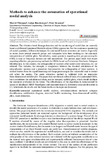Zitierlink:
http://dx.doi.org/10.25819/ubsi/10122Dateien zu dieser Ressource:
| Datei | Beschreibung | Größe | Format | |
|---|---|---|---|---|
| Methods_to_enhance_the_automation_of_operational_modal_analysis.pdf | 1.72 MB | Adobe PDF |  Öffnen/Anzeigen |
| Dokumentart: | Article | Titel: | Methods to enhance the automation of operational modal analysis | AutorInn(en): | Wiemann, Marcel Bonekemper, Lukas Kraemer, Peter |
Institut: | Department Maschinenbau | Schlagwörter: | Automated operational modal analysis, Covariance-driven stochastic subspace identification, Stabilization diagram, Structural health monitoring, Three-dimensional stability plots, Mode extraction, Automatisierte Betriebsmodalanalyse, Kovarianzgetriebene stochastische Unterraumidentifikation, Stabilitätsdiagramm, Dreidimensionale Stabilitätsplots, Modeextraktion | DDC-Sachgruppe: | 620 Ingenieurwissenschaften und zugeordnete Tätigkeiten | GHBS-Notation: | WBF WFB WCW |
Erscheinungsjahr: | 2020 | Publikationsjahr: | 2022 | Auch erschienen: | Vibroengineering PROCEDIA, Vol. 31 (2020), S. 46-51. - https://doi.org/10.21595/vp.2020.21443 | Zusammenfassung: | The vibration-based damage detection and the monitoring of modal data are currently based on different Operational Modal Analysis (OMA) approaches. For the continuous monitoring of modal quantities, different techniques for automated feature extraction are known. Especially in recent years several research groups and companies have been working on the automatic interpretation of stability plots. Nevertheless, many questions regarding data pre-processing for OMA in time or frequency domain are still unanswered. The present paper deals with issues regarding effective pre-processing methods for OMA based on Covariance-Stochastic Subspace Identification. In this context, the orthogonality of matrices after model order reduction, etc. are referred. This includes, for example, a comparison between the classical calculation of the reduced-order matrices and a procedure that preserves the orthogonality of these matrices. A method known from the signal denoising and image processing is also successful used to extract and select the modes. The mode extraction method is validated with an innovative three-dimensional stability plot. This paper does not claim to solve all tasks of an automated OMA, but it contributes the calculation of clean, easy to interpret, stability plots, which should facilitate the automatic evaluation in the future. The effectiveness of the algorithms is demonstrated by means of simulated (3DOF-StateSpace) and measured data of a laboratory structure described in [1]. Afterwards the results and the future works on the topic are discussed. |
Beschreibung: | Finanziert aus dem DFG-geförderten Open-Access-Publikationsfonds der Universität Siegen für Zeitschriftenartikel |
DOI: | http://dx.doi.org/10.25819/ubsi/10122 | URN: | urn:nbn:de:hbz:467-22112 | URI: | https://dspace.ub.uni-siegen.de/handle/ubsi/2211 | Lizenz: | http://creativecommons.org/licenses/by/4.0/ |
| Enthalten in den Sammlungen: | Geförderte Open-Access-Publikationen |
Diese Ressource ist urheberrechtlich geschützt. |
Seitenansichten
301
checked on 01.12.2024
Download(s)
70
checked on 01.12.2024
Google ScholarTM
Prüfe
Prüfe
Diese Ressource wurde unter folgender Copyright-Bestimmung veröffentlicht: Lizenz von Creative Commons


